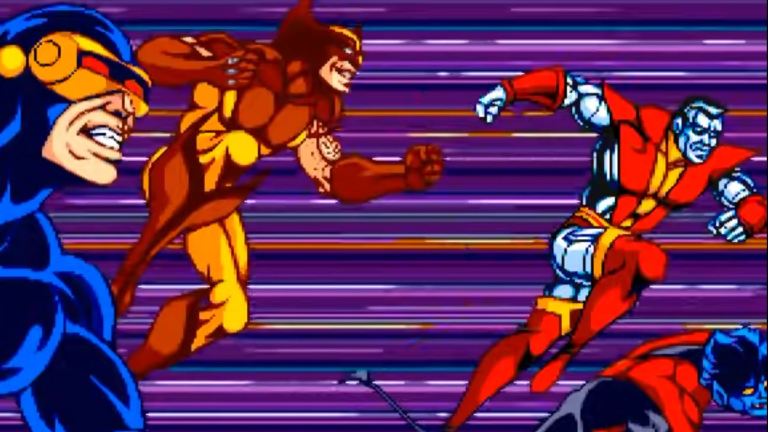Why The X-Men Arcade Game Was a Crucial Part of the Team’s ’90s Golden Age
Ahead of X-Men '97's release, we look back at the game the X-Men game that defined an era.

X-Men ‘97, the latest project from Marvel Studios’ animation department, is set to take fans back to the golden age of Mutant storytelling. The show is a follow-up to X-Men: The Animated Series, which ran from 1992 until 1997. While fans will fondly remember this Saturday morning cartoon mainstay, it’s hard to ignore the impact that the arcade game also had around this same era.
Konami’s X-Men launched in 1992 and has succeeded in creating a legacy that is intrinsically linked to the Mutant mayhem of the 90s. So how did X-Men actually contribute to the popularity of the team? Well to work that out, we first have to go back to the beginning.
The X-Men’s Origins & Rise
The first X-Men comic debuted in 1963. With the incredible Stan Lee and Jack Kirby collaborating on the comic, history was made and a series of characters were born that would forever shape Marvel’s storytelling. Throughout the early years, the X-Men would go through highs and lows, with their popularity increasing whenever the series was making the most of its political nature. With strong themes of “otherness” and discrimination baked into the Mutant concept, the X-Men could often be found at the forefront of some of the most important debates of various eras.
The X-Men, which included characters like Professor X, Jean Grey, Beast, and Cyclops, were proving to be hot commodities for Marvel, but it took some time for the team to really make a mark on the public consciousness. Storm, one of the most well-known and beloved X-Men members, wasn’t introduced until 1975, and Wolverine had only just debuted as a character a year prior (though he wouldn’t join the X-Men until around the same time).
It was arguably the comics of the 1980s that truly defined this team and cemented them as a juggernaut among Marvel’s lines. Indeed, the X-Men went from strength to strength on the page with some truly iconic narratives that have genuinely stood the test of time. The brand continued to absolutely dominate Marvel’s slate throughout the early 90s. It seemed that X-Men mania had reached a fever pitch, so it made complete sense that there would be video game companies out there searching for ways to capitalize on that momentum.
Previous Video Game Attempts
In the late 80s, the video game world tried to take advantage of the increasing popularity, with titles like LJN’s The Uncanny X-Men in 1989, and Paragon Software’s X-Men: Madness in Murderworld, which was released that same year.
However, both of these games failed to live up to expectations and were met with criticism at the time of their release. Neither were as engaging as they could have been and seemed to fail to truly capture the essence of what people loved about the Marvel unit. Graphically both were dull, and mechanically they were unambitious.
The X-Men needed a new studio that actually understood them, and could deliver on what fans truly wanted. Luckily, that’s when Konami entered the scene.
Konami’s Licensed Golden Age
Konami’s impact on the success of the X-Men arcade game and indeed the team’s popularity, shouldn’t be undervalued. The video game developer and publisher only managed to create such a beloved hit because of its prior experience in the licensed field.
Konami had previously been linked to iconic titles like Frogger and Q*bert, but the studio soon demonstrated an uncanny ability to make the most out of licensed projects. 1989’s Teenage Mutant Ninja Turtles arcade game exceeded all expectations with its refined beat-em-up gameplay and obvious love for the source material. Konami’s success with licensed arcade action titles would continue into the ’90s with Aliens, The Simpsons, and Teenage Mutant Ninja Turtles: Turtles in Time just how much value Konami could bring to the often rocky world of licensed video games. These games not only boasted fantastic run-and-gun or beat-em-up mechanics (the latter of which Konami was becoming especially well known for), but they also captured the characters they were portraying with great nuance.
Konami truly put their attention into honoring the properties they were adapting into the video game medium, so that fans who had come from the comics, shows, or movies that these licenses belonged to, would recognize continuity between the portrayals. With fast-paced, multiplayer action, solid graphics, and trusted storytelling, Konami was developing all the tools that ultimately contributed to their own X-Men arcade game.
The Strength Of The Title
While Konami’s 1992 X-Men arcade game clearly benefited from Konami’s growing reputation and the arguable height of X-Men mania, its success is about more than the circumstances. From a financial perspective, it takes something genuinely special to hit the chart-topping sales that the X-Men arcade game experienced regardless of the property that’s backing it up.
X-Men is still hailed as one of the greatest retro beat-em-ups of all time, with its chaotic action sequences and diverse enemy types providing plenty of entertaining combat scenarios. The game pulled from deep comic book lore, allowing players to fight back against Sentinels, Juggernaut, and even Magneto. Despite its limited size and scope, the game made incredible use of the most recognizable faces in the X-Men’s legendary rogues’ gallery. The roster of playable heroes was equally impressive, with the likes of Wolverine, Cyclops, and Storm bringing their unique abilities to the table.
The game’s presentation was just as vital to its incredible success. Its soundtrack is energetic, and its cut scenes feel as if they have been pulled straight from a comic panel. Graphically it’s stunning, with a stylized concept ensuring that these famous faces look their absolute best. A bright color palette certainly helps to back up those visuals. Link all of this to the imaginative level design that took players to an immersive array of locations, and it’s easy to see why the title became so replayable.
Most importantly, the game was an absolute blast. Its simplistic controls ensured that it was accessible to anyone. The multiplayer options also provided a communal aspect to the title, with some variations allowing up to 6 players to contribute to the chaos. Finally, the dream of utilizing the X-Men as a true team of heroes was realized. Fans used to line up to get a go on this beloved title, and the cabinet began to pop up everywhere.
Subsequent console games like 1992’s Spider-Man/X-Men: Arcade’s Revenge continued to add to the team’s video game legacy during the era, but it’s that original arcade title that still maintains the status as one of the absolute greats. As good as those other games were, they couldn’t quite replicate the arcade title’s presentation, gameplay, and aura. They also couldn’t quite replicate that other major piece of ’90s X-Men media quite as well as the arcade game did…
The X-Men Animated Series
It’s a common misconception that the X-Men arcade game was actually inspired by X-Men: The Animated Series. However, that’s not entirely accurate. the X-Men arcade title was released in Japan in January 1992 and received a worldwide debut in March that same year. X-Men: The Animated Series debuted in October of that year.
The arcade game was actually inspired by 1989’s X-Men: Pryde of the X-Men, which was a television pilot that could now be seen as a kind of trial run for what The Animated Series became. Yet, X-Men: The Animated Series still contributed to the arcade game’s growth and vice versa.
Shortly after X-Men: The Animated Series made its debut, it quickly showcased why it would one day become the cultural touchstone it’s considered to be today. X-Men: The Animated Series not only became a success because of the pre-existing popularity of the team on the page, but it also put the team in front of audiences who may have never read a comic before. With the show adapting some of the most beloved narratives from the page (and defining these characters for a new generation), its impact was immediate and extraordinary.
Suddenly, the animated show and the comics were backing one another up. Ratings and comic sales rose almost parallel to one another. Luckily for Konami, the arcade game was caught up in this whirlwind response. Gamers could read about these beloved heroes, watch them battle it out on screen, and then dive straight into their own adventure at the arcade. The game and the show forged a culturally symbiotic relationship. Love for one was often tied to the love of the other. It was the kind of harmony between source material and adaptations that we are often promised and so rarely get. Remarkably, that good feeling couldn’t be contained by that brief window in time.
The Arcade Game Still Shines Today
If the ’90s wasn’t the golden age for the X-Men, it was the era that showed the series’ ability to reach a wide audience without losing the things that made it special. The comics and the animated series were aspiring to reach new creative heights, and millions became X-Men fans during that time. Those factors contributed to the sales of the arcade game, and in turn, the arcade game helped to strengthen the team’s status as a truly beloved superhero property. But, the reason the arcade game still shines so bright today is not just because of the nostalgia associated with the era, the team, or the title. It’s because of the sheer quality of the experience. It is, was, and will likely forever remain an exceptional example of a genre that has aged remarkably well over the last few decades.
The X-Men arcade game’s popularity poses a chicken and egg conundrum to ponder. The popularity of the comics and animated show helped boost its appeal, but the game’s quality also ensured that it hit massive sales and elevated the awareness and love for the titular team in its own right. Looking back, it’s vital to recognize just how much X-Men the arcade game contributed to X-Men history. So once you’ve watched X-Men 97’ and relieved your Animated Series memories, be sure to seek out the 1992 game. It’s truly one of the greats.
